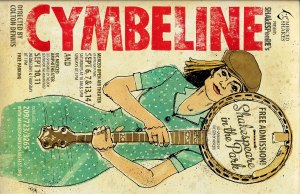by Dorie Perez

Shakespeare was coasting on his laurels when he wrote Cymbeline, one of his last works for the theater, and that wasn’t a bad thing. The literary great was sure to add all of his favorite elements to this dramatic work, weaving comic absurdity with historical narrative and familial strife that, happily, wraps up on a high note. Often overlooked, the play’s high energy and whackamole-style cast of characters cropping up at inopportune moments was showcased by the obvious love and attention taken by the local theater company, Merced ShakespeareFest, to put on the production and create collaborations with the local academic community. The Center for the Humanities at UC Merced played host to the Merced ShakespeareFest’s Fall 2014 production of Cymbeline; its disparate plot echoes the Center’s biennial research theme: “The World Upside Down: Topsy-Turvy.”
Hieke Hambey, Merced ShakespeareFest’s founder and executive director, introduced the play to over 100 audience members on the grounds of UC Merced’s new Wallace-Dutra outdoor amphitheater. This venture between both the local company and the University of California at Merced was the first of its kind, and the broader impact of such a partnership was visible. The play drew mixed audiences from both the larger community and the campus, filling the amphitheater for a full two-night’s run. The play, which continued its scheduled performances in Applegate Park the following weekend, centers on the lovers Imogen and Posthumus Leonatus, who are separated by royal decree and brought back together by farce. Musical interludes offered up by local musicians Evan Hall and Soheil Fatehiboroujeni added an unexpected twist, furthering the quirky take on classic Early Modern themes of mistaken identities, flexible gender presentation, ignoble monarchs and devious servants.
Dr. Katherine Steele Brokaw, assistant professor of literature at UC Merced, served as both the lead actress and dramaturg. Her love of Shakespeare and community theater rings clear: “I like the feeling of giving back to the community through working with Merced Shakespearefest and Merced County Opera in the Schools, both of which have benefited from Center for the Humanities grants.” This is the first time that the ShakespeareFest theater company has had part of their work shown on campus, and Steele Brokaw agrees that these types of community connections have a regional impact. “While there is much scholarly merit in these collaborations, I think that it is even more important that these collaborations are ensuring that the performing arts reach more undergraduates, graduates, faculty, staff, schoolchildren, and community members of all ages and backgrounds in the Central Valley than ever before.”

